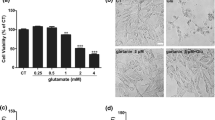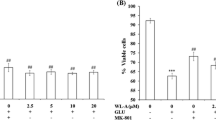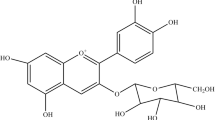Abstract
Folic acid (folate) is a vitamin of the B-complex group crucial for neurological function. Considering that excitotoxicity and cell death induced by glutamate are involved in many disorders, the potential protective effect of folic acid on glutamate-induced cell damage in rat hippocampal slices and the possible intracellular signaling pathway involved in such effect were investigated. The treatment of hippocampal slices with folic acid (100 μM) significantly abrogated glutamate (1 mM)-induced reduction of cell viability measured by MTT reduction assay and inhibited glutamate-induced D-[3H]-aspartate release. To investigate the putative intracellular signaling pathways implicated in the protective effect of folic acid, we used a PI3K inhibitor, LY294002, which abolished the protective effects of folic acid against glutamate-induced cell damage and D-[3H] aspartate release. Moreover, hippocampal slices incubated with folic acid alone for 30 min presented increased phosphorylation of GSK-3β at Ser9, indicating an inhibition of the activity of this enzyme. Furthermore, folic acid in the presence of glutamate insult in hippocampal slices maintained for an additional period of 6 h in fresh culture medium without glutamate and/or folic acid induced phosphorylation of GSK-3β and β-catenin expression. In addition, glutamate-treated hippocampal slices showed increased iNOS expression that was reversed by folic acid. In conclusion, the results of this study show that the protective effect of folic acid against glutamate-induced excitotoxicity may involve the modulation of PI3K/GSK-3β/β-catenin pathway and iNOS inhibition.




Similar content being viewed by others
Abbreviations
- FA:
-
Folic acid
- Glu:
-
Glutamate
- GSK3β:
-
Glycogen synthase kinase 3β
- LY 294002:
-
[2-(4-Morpholinyl)-8-phenyl-4H-1benzo-pyran-4-one
- iNOS:
-
Inducible nitric oxide synthase
- MTT:
-
3-(4,5-Dimethylthiazol-2-yl)-2,5-diphenyltetrazolium bromide
- NO:
-
Nitric oxide
- PI3K:
-
phosphoinisitide-3 kinase
References
Mattson MP (2008) Glutamate and neurotrophic factors in neuronal plasticity and disease. Ann N Y Acad Sci 1144:97–112
Severino PC, Muller Gdo A, Vandresen-Filho S, Tasca CI (2011) Cell signaling in NMDA preconditioning and neuroprotection in convulsions induced by quinolinic acid. Life Sci 89(15–16):570–576
Verkhratsky A, Kirchhoff F (2007) Glutamate-mediated neuronal-glial transmission. J Anat 210(6):651–660
Lau A, Tymianski M (2010) Glutamate receptors, neurotoxicity and neurodegeneration. Pflugers Arch 460(2):525–542
Olney JW (1969) Glutamate-induced retinal degeneration in neonatal mice. Electron microscopy of the acutely evolving lesion. J Neuropathol Exp Neurol 28(3):455–474
Orrenius S, Zhivotovsky B, Nicotera P (2003) Regulation of cell death: the calcium-apoptosis link. Nat Rev Mol Cell Biol 4(7):552–565
Molz S, Decker H, Dal-Cim T, Cremonez C, Cordova FM, Leal RB, Tasca CI (2008) Glutamate-induced toxicity in hippocampal slices involves apoptotic features and p38 MAPK signaling. Neurochem Res 33(1):27–36
Molz S, Tharine DC, Decker H, Tasca CI (2008) GMP prevents excitotoxicity mediated by NMDA receptor activation but not by reversal activity of glutamate transporters in rat hippocampal slices. Brain Res 1231:113–120
Molz S, Dal-Cim T, Budni J, Martin-de-Saavedra MD, Egea J, Romero A, del Barrio L, Rodrigues AL et al (2011) Neuroprotective effect of guanosine against glutamate-induced cell death in rat hippocampal slices is mediated by the phosphatidylinositol-3 kinase/Akt/ glycogen synthase kinase 3beta pathway activation and inducible nitric oxide synthase inhibition. J Neurosci Res 89(9):1400–1408
Pannu R, Singh I (2006) Pharmacological strategies for the regulation of inducible nitric oxide synthase: neurodegenerative versus neuroprotective mechanisms. Neurochem Int 49(2):170–182
Saha RN, Pahan K (2006) Regulation of inducible nitric oxide synthase gene in glial cells. Antioxid Redox Signal 8(5–6):929–947
Brown GC (2010) Nitric oxide and neuronal death. Nitric Oxide 23(3):153–165
Gonchar Y, Burkhalter A (1997) Three distinct families of GABAergic neurons in rat visual cortex. Cereb Cortex 7(4):347–358
Vruwink M, Schmidt HH, Weinberg RJ, Burette A (2001) Substance P and nitric oxide signaling in cerebral cortex: anatomical evidence for reciprocal signaling between two classes of interneurons. J Comp Neurol 441(4):288–301
Licinio J, Prolo P, McCann SM, Wong ML (1999) Brain iNOS: current understanding and clinical implications. Mol Med Today 5(5):225–232
Lopez-Figueroa MO, Day HE, Lee S, Rivier C, Akil H, Watson SJ (2000) Temporal and anatomical distribution of nitric oxide synthase mRNA expression and nitric oxide production during central nervous system inflammation. Brain Res 852(1):239–246
Moro MA, Cardenas A, Hurtado O, Leza JC, Lizasoain I (2004) Role of nitric oxide after brain ischaemia. Cell Calcium 36(3–4):265–275
Nomura Y (1998) A transient brain ischemia- and bacterial endotoxin-induced glial iNOS expression and NO-induced neuronal apoptosis. Toxicol Lett 102-103:65–69
Olivenza R, Moro MA, Lizasoain I, Lorenzo P, Fernandez AP, Rodrigo J, Bosca L, Leza JC (2000) Chronic stress induces the expression of inducible nitric oxide synthase in rat brain cortex. J Neurochem 74(2):785–791
Mattson MP, Shea TB (2003) Folate and homocysteine metabolism in neural plasticity and neurodegenerative disorders. Trends Neurosci 26(3):137–146
Coppen A, Bolander-Gouaille C (2005) Treatment of depression: time to consider folic acid and vitamin B12. J Psychopharmacol 19(1):59–65
Kronenberg G, Colla M, Endres M (2009) Folic acid, neurodegenerative and neuropsychiatric disease. Curr Mol Med 9(3):315–323
Lucock M (2011) Folic acid: beyond metabolism. Journal of Evidence-Based Complementary & Alternative Medicine 16(2):102–113
Liu H, Cao J, Zhang H, Qin S, Yu M, Zhang X, Wang X, Gao Y et al (2013) Folic acid stimulates proliferation of transplanted neural stem cells after focal cerebral ischemia in rats. J Nutr Biochem 24(11):1817–1822
Zeng R, Xu CH, Xu YN, Wang YL, Wang M (2015) The effect of folate fortification on folic acid-based homocysteine-lowering intervention and stroke risk: a meta-analysis. Public Health Nutr 18(8):1514–1521
Budni J, Romero A, Molz S, Martin-de-Saavedra MD, Egea J, Del Barrio L, Tasca CI, Rodrigues AL et al (2011) Neurotoxicity induced by dexamethasone in the human neuroblastoma SH-SY5Y cell line can be prevented by folic acid. Neuroscience 190:346–353
Tagliari B, Zamin LL, Salbego CG, Netto CA, Wyse AT (2006) Hyperhomocysteinemia increases damage on brain slices exposed to in vitro model of oxygen and glucose deprivation: prevention by folic acid. Int J Dev Neurosci 24(4):285–291
Yu HL, Li L, Zhang XH, Xiang L, Zhang J, Feng JF, Xiao R (2009) Neuroprotective effects of genistein and folic acid on apoptosis of rat cultured cortical neurons induced by beta-amyloid 31-35. Br J Nutr 102(5):655–662
Oliveira IJ, Molz S, Souza DO, Tasca CI (2002) Neuroprotective effect of GMP in hippocampal slices submitted to an in vitro model of ischemia. Cell Mol Neurobiol 22(3):335–344
Mosmann T (1983) Rapid colorimetric assay for cellular growth and survival: application to proliferation and cytotoxicity assays. J Immunol Methods 65(1–2):55–63
Peres TV, Ong LK, Costa AP, Eyng H, Venske DK, Colle D, Goncalves FM, Lopes MW et al (2016) Tyrosine hydroxylase regulation in adult rat striatum following short-term neonatal exposure to manganese. Metallomics : integrated biometal science 8(6):597–604
Leal RB, Cordova FM, Herd L, Bobrovskaya L, Dunkley PR (2002) Lead-stimulated p38MAPK-dependent Hsp27 phosphorylation. Toxicol Appl Pharmacol 178(1):44–51
Cordova FM, Rodrigues AL, Giacomelli MB, Oliveira CS, Posser T, Dunkley PR, Leal RB (2004) Lead stimulates ERK1/2 and p38MAPK phosphorylation in the hippocampus of immature rats. Brain Res 998(1):65–72
Dong XX, Wang Y, Qin ZH (2009) Molecular mechanisms of excitotoxicity and their relevance to pathogenesis of neurodegenerative diseases. Acta Pharmacol Sin 30(4):379–387
Sanacora G, Zarate CA, Krystal JH, Manji HK (2008) Targeting the glutamatergic system to develop novel, improved therapeutics for mood disorders. Nat Rev Drug Discov 7(5):426–437
Brocardo PS, Budni J, Lobato KR, Kaster MP, Rodrigues AL (2008) Antidepressant-like effect of folic acid: involvement of NMDA receptors and L-arginine-nitric oxide-cyclic guanosine monophosphate pathway. Eur J Pharmacol 598(1–3):37–42
Beaulieu JM (2012) A role for Akt and glycogen synthase kinase-3 as integrators of dopamine and serotonin neurotransmission in mental health. J Psychiatry Neurosci 37(1):7–16
Beaulieu JM, Gainetdinov RR, Caron MG (2009) Akt/GSK3 signaling in the action of psychotropic drugs. Annu Rev Pharmacol Toxicol 49:327–347
Katso R, Okkenhaug K, Ahmadi K, White S, Timms J, Waterfield MD (2001) Cellular function of phosphoinositide 3-kinases: implications for development, homeostasis, and cancer. Annu Rev Cell Dev Biol 17:615–675
Marone R, Cmiljanovic V, Giese B, Wymann MP (2008) Targeting phosphoinositide 3-kinase: moving towards therapy. Biochim Biophys Acta 1784(1):159–185
Mellor P, Furber LA, Nyarko JN, Anderson DH (2012) Multiple roles for the p85alpha isoform in the regulation and function of PI3K signalling and receptor trafficking. Biochem J 441(1):23–37
Seto SW, Lam TY, Or PM, Lee WY, Au AL, Poon CC, Li RW, Chan SW et al (2010) Folic acid consumption reduces resistin level and restores blunted acetylcholine-induced aortic relaxation in obese/diabetic mice. J Nutr Biochem 21(9):872–880
Budni J, Lobato KR, Binfare RW, Freitas AE, Costa AP, Saavedra MD, Leal RB, Lopez MG, Rodrigues AL (2012) Involvement of PI3K, GSK-3beta and PPARgamma in the antidepressant-like effect of folic acid in the forced swimming test in mice. J Psychopharmacol.
Perez-Costas E, Gandy JC, Melendez-Ferro M, Roberts RC, Bijur GN (2010) Light and electron microscopy study of glycogen synthase kinase-3beta in the mouse brain. PLoS One 5(1):e8911
Woodgett JR (1990) Molecular cloning and expression of glycogen synthase kinase-3/factor a. EMBO J 9(8):2431–2438
Yao HB, Shaw PC, Wong CC, Wan DC (2002) Expression of glycogen synthase kinase-3 isoforms in mouse tissues and their transcription in the brain. J Chem Neuroanat 23(4):291–297
Ferrer I, Barrachina M, Puig B (2002) Glycogen synthase kinase-3 is associated with neuronal and glial hyperphosphorylated tau deposits in Alzheimer’s disease, Pick’s disease, progressive supranuclear palsy and corticobasal degeneration. Acta Neuropathol 104(6):583–591
Kaidanovich-Beilin O, Woodgett JR (2011) GSK-3: functional insights from cell biology and animal models. Front Mol Neurosci 4:40
Sutherland C (2011) What are the bona fide GSK3 substrates? Int J Alzheimers Dis 2011:505607
Bennecib M, Gong CX, Grundke-Iqbal I, Iqbal K (2000) Role of protein phosphatase-2A and -1 in the regulation of GSK-3, cdk5 and cdc2 and the phosphorylation of tau in rat forebrain. FEBS Lett 485(1):87–93
Zhang F, Phiel CJ, Spece L, Gurvich N, Klein PS (2003) Inhibitory phosphorylation of glycogen synthase kinase-3 (GSK-3) in response to lithium. Evidence for autoregulation of GSK-3. J Biol Chem 278(35):33067–33077
Ginsburg GT, Kimmel AR (1997) Autonomous and nonautonomous regulation of axis formation by antagonistic signaling via 7-span cAMP receptors and GSK3 in Dictyostelium. Genes Dev 11(16):2112–2123
Plyte SE, O’Donovan E, Woodgett JR, Harwood AJ (1999) Glycogen synthase kinase-3 (GSK-3) is regulated during Dictyostelium development via the serpentine receptor cAR3. Development (Cambridge, England) 126(2):325–333
Grimes CA, Jope RS (2001) The multifaceted roles of glycogen synthase kinase 3beta in cellular signaling. Prog Neurobiol 65(4):391–426
Kaytor MD, Orr HT (2002) The GSK3 beta signaling cascade and neurodegenerative disease. Curr Opin Neurobiol 12(3):275–278
Luo J (2012) The role of GSK3beta in the development of the central nervous system. Front Biol 7(3):212–220
Bauer M, Willert K (2012) Wnt signaling: the beta-cat (enin)’s meow. Genes Dev 26(2):105–109
Takahashi-Yanaga F, Sasaguri T (2007) The Wnt/beta-catenin signaling pathway as a target in drug discovery. J Pharmacol Sci 104(4):293–302
Coyle JT, Duman RS (2003) Finding the intracellular signaling pathways affected by mood disorder treatments. Neuron 38(2):157–160
Toledo EM, Colombres M, Inestrosa NC (2008) Wnt signaling in neuroprotection and stem cell differentiation. Prog Neurobiol 86(3):281–296
Cárdenas A, Moro MA, Hurtado O, Leza JC, Lorenzo P, Castrillo A, Bodelon OG, Bosca L et al (2000) Implication of glutamate in the expression of inducible nitric oxide synthase after oxygen and glucose deprivation in rat forebrain slices. J Neurochem 74(5):2041–2048
Bal-Price A, Brown GC (2001) Inflammatory neurodegeneration mediated by nitric oxide from activated glia-inhibiting neuronal respiration, causing glutamate release and excitotoxicity. J Neurosci 21(17):6480–6491
Brown GC, Bal-Price A (2003) Inflammatory neurodegeneration mediated by nitric oxide, glutamate, and mitochondria. Mol Neurobiol 27(3):325–355
Figueiredo CP, Bicca MA, Latini A, Prediger RD, Medeiros R, Calixto JB (2011) Folic acid plus alpha-tocopherol mitigates amyloid-beta-induced neurotoxicity through modulation of mitochondrial complexes activity. J Alzheimers Dis 24(1):61–75
Majumdar S, Maiti A, Karmakar S, Sekhar Das A, Mukherjee S, Das D, Mitra C (2010) Antiapoptotic efficacy of folic acid and vitamin B (12) against arsenic-induced toxicity. Environ Toxicol.
Zhang X, Chen S, Li L, Wang Q, Le W (2008) Folic acid protects motor neurons against the increased homocysteine, inflammation and apoptosis in SOD1 G93A transgenic mice. Neuropharmacology 54(7):1112–1119
Feng D, Zhou Y, Xia M, Ma J (2011) Folic acid inhibits lipopolysaccharide-induced inflammatory response in RAW264.7 macrophages by suppressing MAPKs and NF-kappaB activation. Inflamm Res 60(9):817–822
Pahan K, Raymond JR, Singh I (1999) Inhibition of phosphatidylinositol 3-kinase induces nitric-oxide synthase in lipopolysaccharide- or cytokine-stimulated C6 glial cells. J Biol Chem 274(11):7528–7536
Acknowledgements
Research supported by grants from the Brazilian funding agencies: Conselho de Aperfeiçoamento de Pessoal de Nível Superior (CAPES), CAPES/DGU Project No. 173/2008; Conselho Nacional de Desenvolvimento Científico e Tecnológico (CNPq); IBN-Net/CNPq; NENASC project (PRONEX program CNPq/FAPESC). C.I. Tasca and A.L.S. Rodrigues are recipients of CNPq productivity fellowship. This work was also supported by grants from the Spanish Ministry of Science and Innovation SAF2009-12150, Ministry of Education PBH2007-0004-PC, and the Spanish Ministry of Health (Instituto de Salud Carlos III) RETICS-RD06/0026.
Author Contribution
JB, SM, JE, MGL, CIT, and ASR were involved in experimental design. JB, SM, TDC, MDMS, and JE were responsible for performing the work. JB, TDC, MDMS, ALSR, MGL, and CIT wrote the manuscript. All authors approved this version of the manuscript.
Author information
Authors and Affiliations
Corresponding author
Ethics declarations
Conflict of Interest
The authors declare that they have no conflict of interest.
Rights and permissions
About this article
Cite this article
Budni, J., Molz, S., Dal-Cim, T. et al. Folic Acid Protects Against Glutamate-Induced Excitotoxicity in Hippocampal Slices Through a Mechanism that Implicates Inhibition of GSK-3β and iNOS. Mol Neurobiol 55, 1580–1589 (2018). https://doi.org/10.1007/s12035-017-0425-6
Received:
Accepted:
Published:
Issue Date:
DOI: https://doi.org/10.1007/s12035-017-0425-6




